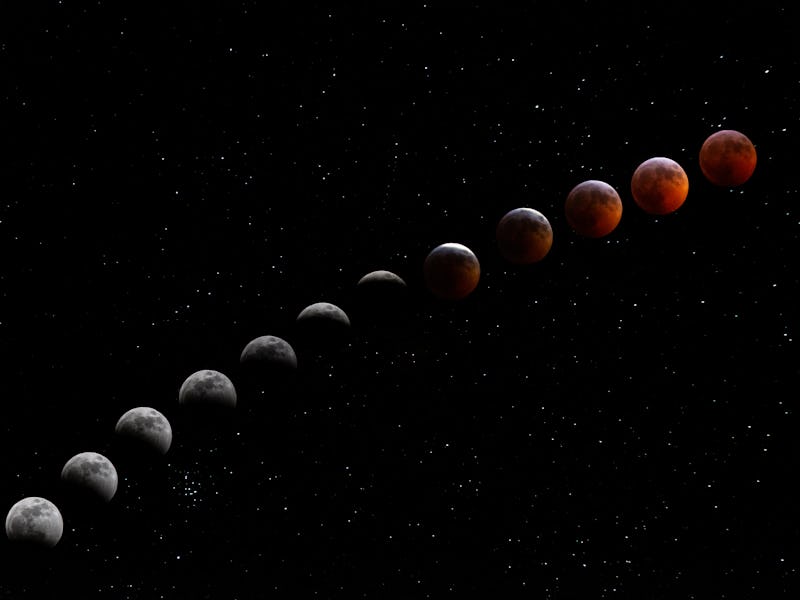Lunar eclipses have one weird effect on birds
And they aren’t the only animals easily swayed by moonlight.

You may have been lucky to catch a glimpse of the total lunar eclipse in 2019. On the night of January 21 to 22, a red-tinged supermoon glowed faintly in the sky while enveloped in Earth’s shadow for over an hour.
But in addition to the spectacular view, the event had a weird effect on birds. Researchers reported in Current Biology this week that during the eclipse, black swifts changed their flight patterns — adding to evidence that moonlight shapes the habits of some species.
A total lunar eclipse took place on the night of January 21 to 22, 2019.
Here’s the background – For up to 10 months out of the year, swifts native to Europe, Asia, and Africa are constantly in motion. During their non-breeding period, they remain airborne around the clock, hunting for insects to sustain themselves; often, they even sleep in midair.
The researchers of the new study wanted to track black swifts, native to North America, to see if their behaviors were similar to other swift species. These birds are the largest swifts on the continent, and in recent years their population has been on the decline. They typically nest on shady ledges on cliffs in the western half of the continent and are known to migrate long distances, spending winters in Central America.
The common swift (Apus apus). This bird is native to Africa, Europe, and Asia.
But much of the bird’s behavior remains elusive. In 2012, study co-author Rob Sparks, a spatial ecologist at the Bird Conservancy of the Rockies, was part of a team that uncovered where the birds go when they’re not breeding. That fact “was a mystery until our discovery, but much of the black swifts’ flight patterns remained unknown,” he tells Inverse.
And in 2017, Sparks helped lead a project to track the foraging and flight habits of the swifts. That led to a collaboration with researchers at the Lund University in Sweden, who had done previous research on other swift species and contributed to the new report.
A sudden surprise – For the new study, researchers fitted seven black swifts with backpack harnesses that carried data-logging devices they wore all throughout migration season. This allowed the team to collect information on the birds’ location, wing activity, and altitude.
They kept an eye on the data to spot when and where the birds’ flight behavior shifted. Overall, they observed that the swifts spent nearly 99 percent of their non-breeding time in the air. They spent less than a day on the ground for more than half the calendar year.
An adult black swift on its nest, spotted in Idaho in 2011.
That wasn’t too much of a surprise, Sparks says. The team had hypothesized that the flight behavior of black swifts would be similar to that of other swifts. But during the total eclipse in January 2019, the researchers witnessed something truly strange.
When the sky darkened, the birds suddenly dropped in altitude and stayed at that level for the duration of the eclipse. After it ended, the birds all shot back up to their previous, higher altitude as if on cue.
“A lunar eclipse triggered a synchronized descent, showing a direct effect of moonlight on flight altitude,” Sparks explains. Outside of that event, the team had also seen the birds fly at higher altitudes during the full Moon. They deduced that the moonlight, or lack thereof, was causing the birds to act up.
Explaining the descent – Sparks says there are a few ideas as to why the birds might react to moonlight.
“[It] could be either a response to predator avoidance or that moonlight provides a foraging opportunity,” Sparks explains. The birds may have flown higher on moonlit nights to spot prey from a better vantage point, using the illumination to their advantage. And during dark nights, they may simply not have enough light to forage for insects.
But this idea needs further exploration. “We are not able to confirm that black swifts are foraging during moonlit nights but hypothesize that they are since they have elevated flight activity during moonlit nights,” Sparks says.
The bigger picture — While moonlight-driven behavior is newly understood in black swifts, they’re not the only species known to be swayed by changes in nighttime illumination. Nocturnal European nightjars also forage on brighter nights and use the light of the moon to determine when to migrate.
A European nightjar.
And while more research would be needed to know for sure, black swifts and nightjars may just be a handful of many birds that find themselves easily swayed by moonlight.
“There is still much to learn about animal behavior in relation to the moon cycle,” Sparks says. For black swifts in particular, a better understanding of their behavior could lead to more robust conservation strategies for this vulnerable species.
This article was originally published on